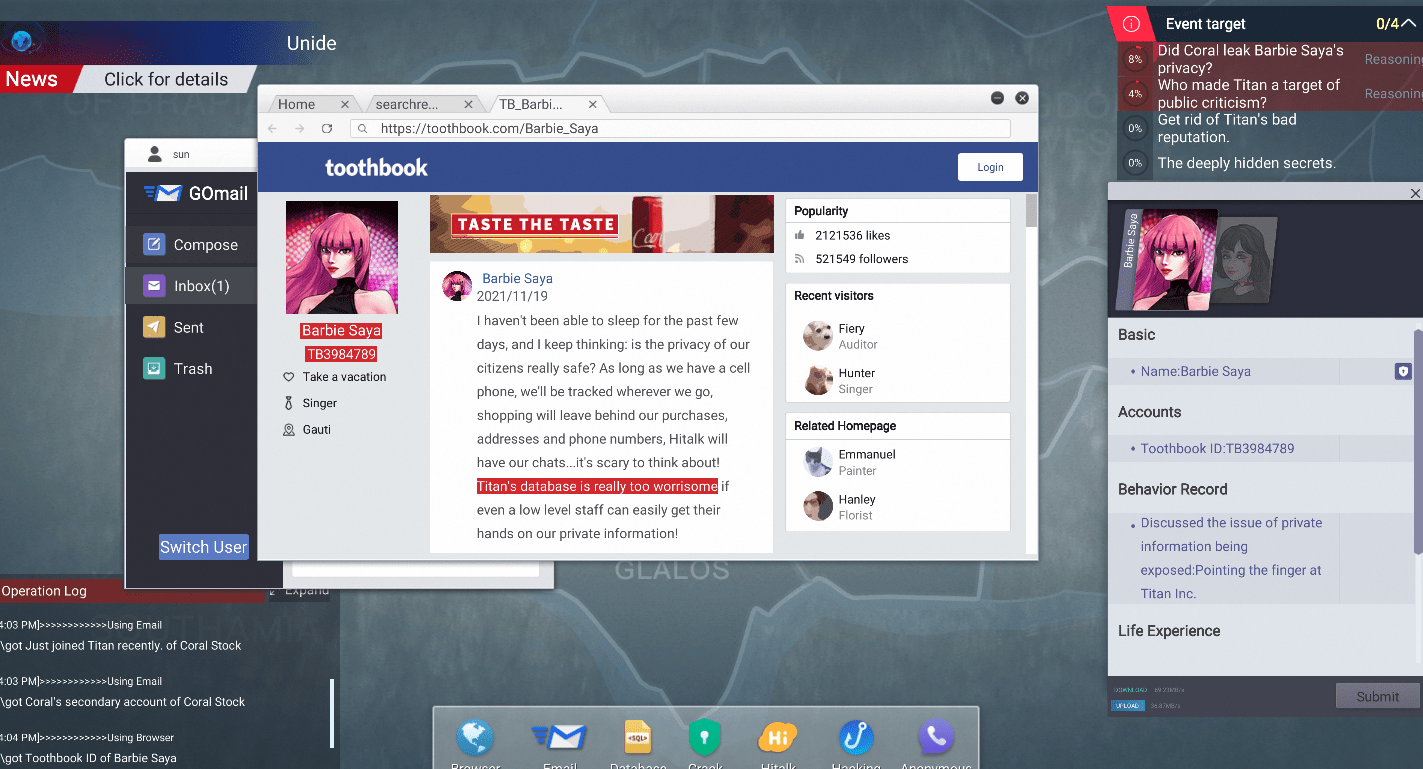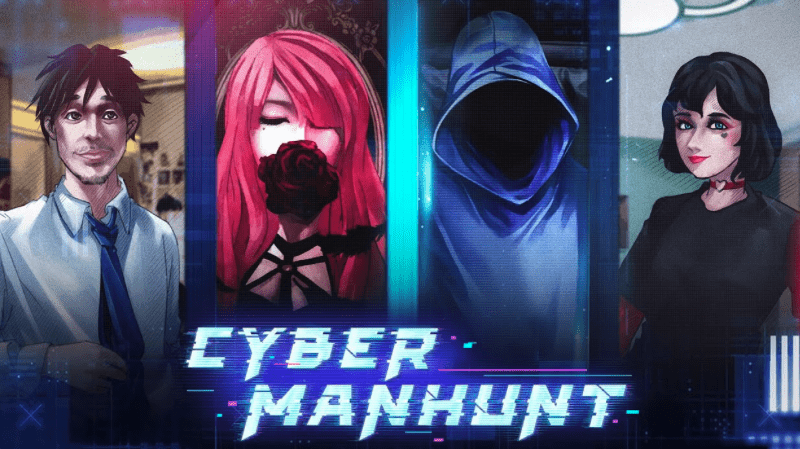Cyber Manhunt is a story-oriented game focusing on big data, hacking, and security driven by stories based on social issues such as cyber violence and privacy breaches. It is developed by Aluba Studio and targeted at people aged 12+ due to the violence involved, and those who enjoy logical reasoning with the deduction and puzzles elements. It is available on Steam and IOS, and I played the Steam version.
The game focuses on embedded narratives where the users uncover the truth behind individual but connected social news by collecting information through puzzles and “hacking“, and keeps players exploring by mixing a sequence of arcs and loops through its architecture in a unique setting of big data and hacking. Focusing on embedded narratives, the players act like hackers to gather information and clues to gradually uncover the truth behind the social news. Throughout this process, the game satisfies the cognizance and competence as motivation for the players to keep exploring the stories in the game. The game involves dynamics in difficulty levels with options to choose whether to make the game harder by disabling the clues, and sub-games at the end of some chapters with different types of games involving different skill chains compared to the process of gathering information during the middle of the chapters. At the same time, the game itself does not have a strict learning curve. The process of gathering information is similar to how we browse the internet, so, with the learned bias that almost all the players have, the game would be familiar to the majority of the players and is easy to get started with.

The main playboard is similar to the desktop of laptops that players usually use in daily life.
With the mechanism of each chapter of the game, the players experience loops, which are combined with skill chains to enable compound interactions. For example, the player first receives the initial information about a person in the news, then he/she can search for the person online, gather some information, search in Titan’s database to gather full identification information, hack the passwords, then login to emails or chatting software, or hacking the phones to receive more information about the person, which sometimes includes initial information about another person. From there, the player repeats the loop over and over again until gathering enough information for all persons related to the news to uncover the mystery behind the social news. During this process, the players have the settled skills chain as mentioned since they must first search online to gather some information to use the database, then, the password hacking relies on the full information usually from the database, the email, and the chat app logging rely on the password hacked, and the phone hacking also involves uncover the person’s habits or preferences first. Such loops also provide clear guidance on how the players could proceed to gather information so that they would not get lost.

For example, the players can only crack the password until they gather enough information including real name, nick name, ID number, cell phone number, date of birth, and house number.
At the same time, the game architecture mixes a sequence of arcs with those loops. There are major stories that go through the whole game, i.e. uncovering who Van is, the story of the player’s character, and what the company Titan is working on, with chapters for individual social news. At the start of each chapter, players are in the mental model that serious social news happens. They are given the decision that they must uncover the truth of the news and resolve its impact on Titan, the company that the player works for. So, they take action as in the loops mentioned above following the rules that restrict the procedures, following the skill chains, and looping into a new round of information seeking after discovering some of them. At the end of each small chapter, there is a report about the whole story that the player uncovered as feedback for the current arcs and goes to the next one. The game architecture connects all the individual chapters through the overlapping characters. For example, I saw the company and its CTO who is mentioned in one of the chapters as a driving force behind the news is involved directly in the later chapter as a main character and found that he turned out to be driven by Van, the major mysterious character that we want to uncover the story for through the whole game. In this way, though the news in different chapters is separated, the players will gradually find their connections and that they are all linked to Van to uncover the final main story.

In the middle and end of each chapter, the game includes the deduction board that guides the players to uncover the actual stories with clues that they collected.

At the end of each chapter, the game provides a summary of the story as the feedback of what information and story are uncovered by the players.
Finally, the game has a unique setting of big data and security issues, which is connected to real-life examples. This would encourage players to pay attention to their own data breaches that could happen frequently and unintentionally. For example, much information is collected through social media where the characters in the game post photos but do not realize that they include important information, including where they live and their IDs. In this way, the players might reflect on their own social media experiences and might pay attention next time when posting any photos of information, preventing data breaches. It is also uncovered at the end that the player is actually an AI developed by Titan, but the Titan is experimenting with whether it is OK to allow the player, or AI, to have human emotions. This is also an arguable question that is discussed a lot nowadays, so it makes the game close to reality, and also the players, and encourages players to reflect on their own experiences to be more careful of their usage of social media.

A photo uploaded on social media platforms might include the person’s ID. This is also related to lots of personal private information breaches in reality.

It is uncovered with the help of Van that the player is actually an AI developed and experimented on by Titan. In the game play, I actually thought Ashley is a bad character that is work against the player, but it turns out that she defend the player to be continuing observed and monitored instead of destroyed directly.
However, the game still has some flaws, such as the loops repeating multiple times, making the process of gathering the information a bit boring, especially in the later chapters where such repetition occurs too much. During my play, almost every information-gathering process is the same, following the loop as described above. I feel like when I played the game, I was just clicking through each component to unlock the stories. It was the eagerness to uncover all the stories that drove me to play the whole game instead of the game mechanism. I enjoy learning the story and details of each character more than the process of gathering such information. I also enjoy the dynamics brought by the sub-game with different mechanisms at the end of each chapter related to how the stories in the chapters related to the main story about Van, Titan, and the player. I think it might make the game more fun if the loop could be altered in the middle of the game, including adding new skills, introducing new approaches to gather information, or thinking about how to add the games with different mechanisms into the process of information gathering.

This is the sub-game that I like the most. It is about how to reduce the impact of social media on Titan by increasing spotlights to non-related topics and reducing the influence of the bad news on Titan. However, such game only occurs at the end of each chapter, making the game losing some dynamics.



